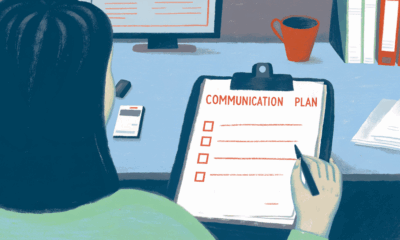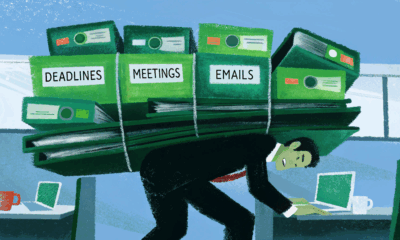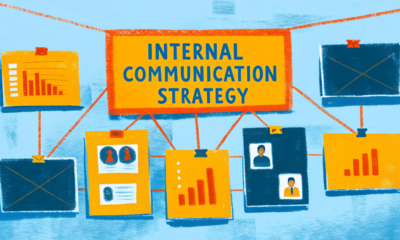Productivity
7 Tips to Implement Work From Home Policy in Your Company

Implementing a work-from-home policy has been a solution for numerous companies in addressing the prevalent issue of burnout. Failure to provide employees with remote working options has resulted in mass resignations for some companies unwilling to adapt.
However, you can avoid this scenario. If you want to keep your skilled workforce and keep up with the remote working trends, then you are in the right place. This article will provide you with comprehensive information on how to organize remote teams. Let’s delve into it.
Why you need a work from home policy
Remote work isn’t just a luxury anymore; it’s become an integral part of how businesses thrive in the modern world. A strong work-from-home (WFH) policy isn’t just about offering flexibility — it’s about giving employees the tools and structure they need to excel, wherever they are.
A solid WFH policy helps cultivate a work-life balance that’s not dictated by office hours. By cutting out the commute, employees gain time to focus on personal goals, improve their well-being, and become more productive. When employees are happier, they’re more engaged, which translates into better results for the company.
A well-crafted remote work policy also opens up opportunities to tap into a global talent pool. Companies no longer need to be limited by geographical constraints, and the range of perspectives and ideas that come with a diverse workforce can drive innovation and creativity.
But a WFH policy isn’t just about offering the freedom to work from anywhere — it’s about making sure employees have everything they need to thrive. That’s where companies like Twitter and Ctrip come in. They’ve both crafted remote work strategies that support their teams, showing how a thoughtful approach can lead to success. Let’s explore how they’ve made remote work work for them.
Twitter and Ctrip: companies that adopted remote work
In the realm of work from home policy, numerous companies have employees working remotely, and their sizes can range significantly. For the purpose of this section, we will focus on two companies in particular. The first is a well-known tech giant that you’re already familiar with, and the second is a relatively unknown company.
We’re going to compare approaches, gauge their respective results, and see what insights we can get from their experience. Let’s start off with the multibillion-dollar tech company that played a big role in revolutionizing the social media landscape.
Twitter, undeniably one of the largest tech companies globally, has implemented a work from home policy and even facilitated the transition for its employees. Instead of purchasing equipment for its employees, Twitter opted to let them handle the setup process themselves.
How does this ease the transition, you ask? Well, Twitter reimbursed employees for the costs they incurred during the home office setup. The cashback policy covers everything from desks, ergonomic chairs, printers, and other home office equipment that their employees may need.
Even any online fees that their employees may incur from video conferencing services, data consumption, or project management software will be covered by the company. Twitter is a shining example of how to make a remote transition as easy as possible for employees.
Ctrip
Back in 2016, a Chinese travel agency that employs 16,000 people wanted to explore the feasibility of a remote working system to see if it could reduce overhead costs and/or increase productivity amongst their staff.
They started by assigning small groups from their call center department to a home-based arrangement. The early results were quite promising since there was a drop in resignation rates, better overall performance, and even an improvement in morale based on employee feedback.
The implementation of a work from home policy led to significant cost savings for the agency, amounting to $1,000 for each employee who transitioned to remote work. This was achieved by freeing up office space that the employee would have otherwise occupied. Following the positive initial results, Ctrip extended the policy to the entire agency.
However, upon its implementation, a surge of complaints was received from employees. It is noteworthy that the majority of the complaints centered around a common issue—loneliness, which, in turn, resulted in reduced productivity. Continue reading to discover ways to counteract both these challenges.
Key performance indicators
One of the trickiest parts of managing remote teams is keeping them accountable for their performance. After all, it’s tempting for many remote workers to slack off, since their boss won’t really know.
Thankfully, there is a solution to address this issue through the implementation of a work from home policy. You can establish key performance indicators (KPIs) for each remote team to ensure they maintain their motivation, as you can actively measure their progress over the past weeks, months, or even years.
It’s advisable to use KPIs to monitor short-term productivity levels of remote teams, with an ideal monitoring period ranging between two and four weeks, depending on the nature of the team’s department. For instance, if you’re overseeing a marketing team, measuring performance on a month-to-month basis is more reasonable, as it takes time to plan and execute campaigns. In contrast, for sales representatives, who usually close deals in less than a week, monitoring their numbers over the past 14 days can indicate a decline in team performance.
Roadmaps
In addition to establishing KPIs, a work from home policy can also benefit remote teams by providing them with roadmaps to keep them on track. In a physical office, managers can easily call employees into meetings and communicate goals and targets effectively. However, this is not always feasible for remote teams, despite the availability of various online conferencing tools.
To address this challenge, creating a roadmap that outlines the goals and targets for the next month, quarter, or year can be helpful. Roadmaps are akin to detailed to-do lists that cover an extended period of time. When crafting a roadmap for remote employees, it’s crucial to be specific and transparent about the goals. Vague targets can hinder performance.
Moreover, we recommend getting feedback from remote workers to optimize the roadmap. By doing so, remote teams can stay on track and achieve their targets, ultimately contributing to the overall success of the work from home policy.
Health initiatives
Let’s face it, remote workers aren’t going to be as productive at home as they potentially could be if they’re in poor health. You might think that remote workers should be healthier than those who spend all their time in the office, since they have more flexibility to go to the gym.
Sadly, this isn’t the case. Despite having the “freedom” to get a solid workout in each day or sleep a full eight hours every night, remote workers usually suffer from health problems due to pulling all-nighters or procrastinating then cramming their tasks — which is mentally unhealthy.
If you want your remote workers to be physically and emotionally healthy, then you need to promote healthy heart habits such as regular exercise and good nutrition. Cardiovascular disease is a prominent risk for those who work at home, so take the initiative to protect your employees.
Encourage teamwork
Many companies are hesitant to implement a remote work policy due to concerns about potential collaboration challenges that may arise. And in some cases, their fears may be justified.
It’s well-known that some remote teams tend to collaborate less frequently than their in-office counterparts. However, there are always solutions to the obstacles that remote teams face.
To promote teamwork in your remote teams, it’s essential to make everyone feel like they’re part of a larger purpose. Something as basic as saying “hello” every morning in the team chat can help.
Maintaining a positive tone in the team chat is crucial to boost the morale of your remote team, as the online environment can significantly impact their productivity. Avoiding negativity is key, which is why it’s important to establish a remote work policy that encourages positivity and collaboration.
Additionally, scheduling daily meetings through an online conferencing platform can foster a sense of unity in your virtual team, regardless of the subject being discussed. Whether it’s about company updates, marketing strategies, or simply checking in on everyone’s well-being, the opportunity for team members to interact can make a significant difference in their overall performance.
Finally, if you’re the one in charge of the remote team, then share informative articles and TED Talks every week or give frequent feedback in a constructive, respectful way. This will not only portray authority, but also motivate employees to constantly work on honing their skills.
Foster a sense of ownership
Another great tip for implementing a work from home policy is to foster a sense of ownership within your remote teams. When employees feel responsible for the results of their work and believe they have the autonomy to make decisions, their engagement and motivation often skyrocket.
Encourage remote workers to take full ownership of their projects or tasks by giving them the freedom to manage how they approach their work. This autonomy not only builds trust but also makes employees feel more invested in their work, knowing that their decisions directly impact the success of the project or team.
It’s essential to communicate the trust you have in them and to offer support when needed, without stepping in too often. By fostering a culture of ownership, remote employees will feel more empowered to contribute to the success of the team and will likely take more initiative to deliver high-quality work. This approach can help drive productivity while also maintaining a positive and motivated work environment.
Essential gadgets
Any company with a remote team should ensure that they have the necessary tech tools to do their job right. This mainly means hardware, but could also extend to software in some situations. Modern remote desktop programs can be especially useful when working online and from home. Even the mundane act of getting a laptop for your employees can make a big difference.
To ensure that your remote employees can work effectively, it’s important to consider their equipment needs. For instance, if they’re working on a tablet, providing Bluetooth keyboards can be beneficial, especially for jobs that require a lot of typing, such as writing or live chat customer service. This can be a helpful aspect of a comprehensive remote work policy.
While not as essential as laptops or Bluetooth keyboards, noise-canceling headphones are also a handy gadget for any remote employee to have, since they can help them stay focused even when they’re working in hectic environments.
Moreover, for those struggling with remote work productivity, provide productivity apps and time tracking tools with timesheet system to keep track of their performance. Also, encourage communication amongst employees so that the experienced employees can share tips with juniors.
Promote work-life balance
Finally, it’s essential to emphasize the importance of work-life balance in your work from home policy. Remote work can blur the lines between personal and professional life, leading to overwork and burnout. Encourage employees to set clear boundaries between work and their personal time, such as sticking to set work hours and taking breaks throughout the day.
Offer flexibility where possible, but also ensure that employees disconnect when needed. You can support this by implementing policies around time off, mental health days, and encouraging them to take their full vacation time. This not only helps to avoid burnout but also ensures that employees stay motivated and productive over the long term. Remind your team that it’s okay to take breaks and that their well-being is just as important as their work output.
Conclusion
As you can see, organizing remote employees doesn’t have to be a nightmare or an uphill battle if you utilize some of the tried-and-tested strategies that we’ve outlined above. Remote teams, when managed properly, can be just as productive and collaborative as their in-house counterparts.
Whether you’re a social media goliath or a travel agency, the challenges remain mostly the same for employees who go remote. When you cover the needs of your staff, they’ll be just as productive from home as they would be in the office – if not more.
Productivity
Work From Home Statistics: 10 Facts That Will Surprise You

For many companies, working from home is still a novel idea, therefore data on remote work is limited. However, these ten work from home statistics appear to indicate that allowing employees to work from home, or working from home yourself, has tremendous value:
1. Employees are more productive when they work from home
To make a profit, businesses require productive professionals. Employees, on the other hand, are only productive around 77% of the time, according to research, and are more likely to be productive when working from home.
Majority of the employees polled in favour of being more productive when working from home. This is because of the lack of noise and interruptions that come with working in a crowded workplace, the removal of daily commutes, and the improved comfort of self-described introverts.
Coworkers, ringing phones, loud discussions, and individuals moving around in the workplace are all common sources of distraction for employees. It takes an employee an average of 23 minutes to refocus after being distracted. Most of these distractions are not even an issue when working from home. Introverts claim that they can get more work done when they’re at home, away from the pressures of having to interact socially with coworkers.
Others attribute their greater productivity to the fact that they are no longer wasting hours each day driving to and from work. Because they don’t have to commute, they’re more at ease and less resentful of working longer hours from home to complete a job. They also can use time management apps that will help them to stay productive while working from home.
2. Employees who work from home are 52% less likely to take time off
According to a CoSo Cloud survey, employees are encouraged to work more efficiently at home and take fewer vacations. Employees who work from home are more likely to work without calling in sick and also take fewer vacations resulting in lower absenteeism.
3. Managers of remote employees are concerned about reduced productivity, according to 82 % of them
Even though workplace productivity data by Owl Labs have repeatedly demonstrated that remote work increases productivity, managers who work with remote employees are nonetheless concerned about decreasing productivity and focus, as well as whether remote employees complete projects on time. They appear to be less concerned with employee loneliness and employee future.
Pulse surveys are a great way to take your work from home experience up another notch. Pulse survey benefits include greater flexibility, reduced commute times, and increased productivity since you’re able to focus on what matters most – company tasks.
4. Attrition is reduced by 50% when employees work remotely
Because employees are more satisfied at work when they work remotely, there is a significant reduction in employee attrition. When individuals leave a job, it’s usually because they’re dissatisfied with it.
Working from home, according to Stanford Business, is considered as a huge perk that could compensate for any other shortcomings in the position. Employees who stay on the job receive more experience and lower the need to train new employees, enhancing the overall performance of the team.
5. Working from home jobs have grown 115 % in the last decade
According to the State of Telecommuting, work from home jobs have grown 10 times faster than traditional jobs. This measure can be interpreted in a variety of ways. It’s possible that firms are understanding how much more productive individuals are when they work from home, and as a response, they’re expanding their workforce to include more remote working positions. It’s also possible that more people are keen to build their own work-from-home opportunities.
6. People who work from home on a regular basis are more satisfied
Employees who work from home at least once a month are 24 times more likely to be pleased at work, according to OWL Labs. There are a variety of reasons why someone can be happier working from home, but the most important is that happiness rises consistently.
7. Companies with remote positions have a 25% lower turnover rate
According to Owl Labs’ 2017 state of remote work report, positions that allow for working from home had a 25% lower turnover rate. This is most likely related to the job’s pleasure and stress levels; if employees are grateful for the ability to work from home, they are much less likely to quit.
8. Organizations with a completely remote workforce hire 33% quicker
The same report by Owl Labs states that if your entire team works remotely, you’ll be able to fill positions 33% quicker than your competition. This has an impact on your team’s overall output because you’ll be stuck with open positions for much shorter periods of time, and you’ll spend significantly more time at peak teamwork and production as a result.
Building a totally remote team, on the other hand, is difficult, especially if team members are in different parts of the world. It’s critical to create a culture where everyone feels valued as a team member.
9. At least some work is now done from home by 23% of employees
According to the Bureau of Labor Statistics, 23% of American workers currently work from home often. The number of people working from home is steadily increasing, indicating that companies are more confident in their employees’ ability to be productive under these circumstances.
10. 74% of experts believe that remote work will become the norm soon
When asked about the future of work, 74% of professionals predict that remote work will become the accepted norm. According to Forbes, this viewpoint is held by 76% of entrepreneurs, indicating that traditional office spaces, as well as co-working spaces, will soon decline to be in use.
Large firms such as Twitter and Slack have already stated that all employees would be able to work from home on a permanent basis, while Salesforce has just unveiled their hybrid work plan. Because of the precedent these companies are setting, as well as employee expectations, not having a remote work option will be damaging to a company’s ability to move forward.
Other advantages of working at home
According to these working from home statistics, productivity gains, effectiveness, and improved work performance are the evident benefits of working from home, but they aren’t the only ones a business may experience by implementing a work from home policy. The following are only a few of the other benefits:
1. Reduced office expenses
If you own your company and now rent an office, you should calculate how much money you’d save if you went completely remote. Allowing all your workers to work from home at the same time is a risky decision, but if it’s feasible for your company, you could save thousands of dollars per month.
2. Better job opportunities
If you’re recruiting remote employees, you won’t be limited to those in your immediate neighborhood; you’ll be able to hire people from all over the country, and even continents. This broadens your range of possibilities and allows you to locate better matches for open opportunities.
3. Benefits to the environment
People who work from home will not drive or even take public transportation to work. As a result, your team’s greenhouse gas emissions will be greatly reduced, which will have a positive impact on the environment.
Challenges of working from home
Despite its many upsides, remote work isn’t without its drawbacks. For remote setups to be sustainable, it’s essential to address the common challenges employees and organizations may face:
- Isolation and Loneliness
Many remote employees report feeling disconnected from their team. Without the daily interaction that comes with office life, it’s easy to feel left out or disengaged. This can affect mental health, collaboration, and overall job satisfaction — especially for extroverted team members. - Communication Barriers
Remote work depends heavily on digital communication tools, which can sometimes lead to misunderstandings, delayed responses, or misaligned expectations. Without face-to-face contact, building rapport or reading tone and intent becomes more difficult. - Work-Life Boundary Blurring
One major downside of working from home is that it can be difficult to “switch off.” When your home becomes your office, boundaries can dissolve. This often leads to burnout or overwork, especially for employees who feel pressured to be “always available.” - Performance Monitoring and Trust Issues
Some managers struggle with trusting employees they can’t see. As mentioned earlier, 82% of managers are concerned about productivity levels. This can lead to micromanagement or the adoption of invasive monitoring tools, which can erode morale and trust.
Last thoughts
People seek flexible schedules and the option to work from home or in a hybrid work style, even if only on an occasional basis. Furthermore, by implementing a few relatively simple regulations, businesses might save money while increasing productivity and employee morale.
Depending on your arrangement, working from home can be a more efficient work environment than a traditional office cubicle, also allowing you to achieve a better work-life balance. The epidemic has altered the way we work, with more businesses opting for at-home solutions.
Make sure that your staff is comfortable, organized, and healthy to ensure that their production remains at a high and consistent level for months to come.
Productivity
15 Surprising Employee Productivity Statistics That Will Impress You

Employee productivity, according to WhatIs.com, is “an evaluation of an employee’s or group of employees’ efficiencies.”
Employee productivity, in short, assesses how much useful work an employee performs for an organization over a given time. If a company wants to prosper, it needs people that are highly productive.
We’ll give you 15 intriguing and useful employee productivity stats that are applicable today. Hopefully, you can use this information to develop new policies in your company and improve the general efficiency of your team.
Employees prefer to work alone 86% of the time
According to a study done by Apollo Technical, whether working from home or at the office, on average 86% prefer to work alone. Employees report that being able to separate oneself from others reduces distractions. They also feel less motivated to deliver or connect in certain ways, allowing them to concentrate only on their tasks.
This autonomy pertains to projects as well. Many workers would rather work on projects on their own than rely on others to complete their part of a collaborative effort. This is still applicable in most circumstances, even if working alone requires the person to work harder.
Employees believe that interactivity may boost workplace productivity by 89%
When projects are gamified and become interactive, many employees believe they become more competitive and motivated to do them, which enhances workplace productivity. Statistics on productivity and technology continue to reveal a link between technical complexity and output.
80% of employees require financial assistance
According to a poll of 220 clerks, over 175 of them wished their employers had provided financial assistance to them. Employees who are concerned about their financial situation are less productive than those who are financially comfortable. Employees seek loan counseling, and it’s a relatively inexpensive practice to start in most organizations. They believe that if they were more confident in their financial management, they would be happier and more productive in general.
Every three minutes, the average employee is interrupted
After an interruption, it may take people 23 minutes to refocus. Employees are interrupted every three minutes and five seconds, according to a study done by experts at the University of California, Irvine. That indicates that for every 26 minutes spent at the office, workers get three minutes of work done.
The average employee works for less than three hours daily
Every day, the average worker is only productive for 60% or less across all industries. However, for some working professionals, this ratio reduces dramatically. According to VoucherCloud research, the average employee is only productive for merely two hours and 23 minutes each day.
This means employees are generally unproductive for five hours and 37 minutes per day, assuming an eight-hour workday. Every day, that’s a significant amount of time and money squandered by the employer.
Employees cost $28 billion a year to using facebook
Facebook also costs employers several billion dollars per year, according to research done by Hubspot. This is because employees spend roughly 32% of their workdays on Facebook. Generally, they won’t be working if they are on social media. Each year, this productivity loss results in a significant amount of money being squandered.
Multitasking has been shown to reduce productivity by 40%
Multitasking, according to productivity data, can reduce your productivity rather than increase it. Constantly switching from one job to another is stressful to the brain, making us less productive or causing toxic productivity.
Try incorporating the 1-3-5 rule into your work routine instead of handling multiple projects at once. This method works by handling the most difficult things first, then moving on to medium-level jobs, and finally finishing the day with the simplest tasks.
Employees involved in decision making are more productive
Employees who are allowed to engage in “major decision-making sessions” are often more efficient, according to another study. When employees are given a say in company decisions, they feel as if their position in the firm counts – as if they have a perspective that is heard. Higher productivity rates are a result of these feelings.
People often feel like they helped develop something when they’re investing in it and have a hand in improving it. They want it to succeed, therefore they put in extra effort to make it happen.
Stress has a negative impact on productivity
According to research by Go Remotely 50% of employees miss one to five hours of work every week due to stress. Managers usually take several actions to reduce the stress levels which ultimately affect the productivity of employees. These measures may include offering a higher salary, paid vacation leaves, more flexibility in work schedules, and wellness initiatives for better productivity levels.
Appropriate nutrition can boost work productivity by 25%
A productivity study by Go Remotely that lasted three years questioned 20,000 employees per year. They came to the conclusion that employees who ate fruit and vegetables at least four days a week were 25% more productive than those who did not.
Employees are more productive around the holidays
According to workplace productivity statistics, the main causes for the productivity decrease among the 35% who feel less productive are social and personal responsibilities, increased year-end workload, flu season, and holiday shopping. The more productive employees, on the other hand, avoid common office distractions to depart on time.
Stress and a lack of work-life balance
According to the Yerkes-Dodson Law, our ability to perform at our best is determined by the amount of pressure we are under for the work we are performing. When we are under too much stress, our performance suffers dramatically. Productivity suffers when an employee’s mental and physical resources are depleted.
66% of 1,077 adults surveyed by Glassdoor believe they would be better and more productive employees if they had more sleep, especially those between the ages of 18 and 44. Furthermore, persistent stress is linked to absenteeism. According to research by the Health Advocate, one million employees miss work every day owing to stress.
Freelancers are productive 36 hours each week
According to a study done by Yahoo Finance, in comparison to the average office worker, the average freelancer works for roughly 36 hours each week. If freelancers work five-day weeks like the rest of us, that equates to almost seven hours of productivity per day.
They put forth more effort than those in other professions since the amount of time they spend working is directly proportional to the amount of money they earn. But the overall productivity of a freelancer also depends on the type of technology, software tools, and techniques they are using.
Moreover, it is also noticed that companies who need to leverage on-demand workforce onboarding benefit from a freelance management system. It makes onboarding and offboarding, invoicing, payment, and workforce classification easy and also help managers help find the right talent quickly.
Environment influences productivity
According to a Robert Half poll, 71% believe that listening to music at work makes them more productive. According to a CareerBuilder poll, 53% are less productive when their workplace is excessively cold. According to Gallup’s State of the Local Workplace, 85% of employees are neither engaged nor actively disengaged at work, resulting in $7 trillion in lost productivity. According to research by Exeter University, open workplace layouts cause a 32% decline in overall happiness and a 15% drop in productivity.
Meetings are exceptionally unproductive
Meetings aren’t necessarily a waste of time, but they aren’t always helpful either. Atlassian did a study on meetings that revealed the following startling findings:
- 91 % daydream in meetings
- 39 % have slept in meetings
- 96 % have missed at least one “mandatory” meeting
- 73 % started working on other tasks while attending a meeting
- 50 % of employees perceive meetings to be a waste of time
AI programs enhance productivity up to 40%
In 2025, AI programs like ChatGPT, Grammarly, Jasper, and Notion AI are the norm at the workplace. They assist in writing, coding, note-taking, calendaring, and research — making employees free up to 10 hours a week.
This increase in efficiency is supported by an MIT-Stanford joint report, which found that employees using AI finished work 25% faster and with better quality. AI is thus widely preferred today by writers, marketers, developers, and customer support.
Each team utilizes these tools differently. Writers have AI to write and rewrite faster. Developers utilize it to code and debug. In customer service, AI speeds up responses and handles repeat inquiries.
Aside from helping at work, AI also reduces decision fatigue. By taking over routine tasks, it clears room in workers’ brains for more complex and creative work.
Looking ahead, AI will be integrated into most workplace platforms. Those who can harness these tools effectively will have the upper hand as AI becomes the norm in workflows on a daily basis.
That said, AI is a tool — not a replacement. Human creativity, judgment, and empathy remain essential for true success. AI boosts productivity, but it can’t replace the value people bring to the workplace.
The takeaway
Given the numerous advantages of workplace productivity, it’s no surprise that businesses are always looking for new ways to boost productivity and developing unique productivity metrics to effectively evaluate it.
It is difficult for any organization to maintain a specific level of productivity, especially considering the numerous factors that can influence it. Even so, anyone who wants to give it a shot will be handsomely rewarded.
Productivity
Super True Mental Health Memes You’ll Probably Relate To

Although relatable humor about traumas can reduce one’s loneliness, it is still debatable how medicinal they can be. Almost a decade ago, awareness of mental breakdown was quite low and people did not talk much about it as it was considered taboo.
However, recently people have started talking about it openly. On social media platforms, you’re just as likely to come across references to depression as you are on medical forums, and mental state memes have seen to grow in popularity as more and more people relate to it.
While positive mental health can be treated by laughter, it is also treatable through improved collaboration and communication among teams.
As we begin with a relatable mental breakdown meme, we want to remind you that laughter is the best medicine. It’s actually true!
Laughter has numerous psychological, and emotional advantages, some of which may surprise you. It can help improve your immunity and attitude by releasing serotonin, strengthening blood flow, and much more.
Without further ado, we present you the most relatable mental health memes – hoping to make you laugh.
Therapy works – at least in mental breakdown memes
While most people have taken advantage of therapy, there are still some of us who need the reassurance of the fact that we will most definitely make it through the hurdles. Especially with problems at the workplace in large companies.
As part of that, first comes a therapy-related mental breakdown meme. Although therapy itself might not be so funny, the memes definitely are!

threads.net
Gotta look sane in front of the therapist or they will think something is wrong with me. Oh wait, I’m already there to seek help.


google.com
Haha, the advisor should definitely be a therapist!

theconversation.com

pinterest.com

The-breakdown.co.uk
Oops, that escalated quickly…

ranker.com
Same boy, same! We are also as shocked as you are at our problems.

images.app
It better work fast now!

feelmo.com
Socially awkward – let’s experience unworldly vibes in humor
Remember the socially awkward puberty phase we all went through? The phase continued to grow for some of us for different reasons. Even though being socially awkward can cause a cringe-worthy urge in your stomach, we assure you that these mental breakdown memes will unfold laughter from your stomach.

pinterest.com
Maybe we need to call Rapunzel for help now.

ebaumsworld.com
The struggle is real

Cheezeburger.com
Ignorance is bliss.

wattpad.com
Feeling anxious? Let’s combat it with self-defeating humor
Aahh, is there a better way to feel less anxious than self-defeating humor? At least we think that nothing can go wrong with this kind of humor and we are lighting up with hope. So bring it on Mamma Mia.. or should we say, here we go again?
All night, every night!!

Ranker.com
Ohhh look, we’ve got guests over.

Ranker.com
High fives always make things better.

thehealthy.com
At least we’re laughing… right?

Humorously self-actualizing yourself
Even if the intent is humorous, at least we are self-actualizing ourselves. Great minds once said that self-reflection is the key to success. In this case, it might not be the success we are hoping for, but it is definitely a good laugh. And what’s better medicine than laughter?
Haha, no matter how I am doing – I will still always be there for you, pal! Also, maybe next time I should take my own advice too.

Pleated-jeans.com

images.app
The “of course I am fine clad”
One of the most detrimental phrases of mankind’s history is “I’m fine”. This casual phrase has now become the center of attention for many mental health memes. Here’s to all the humor directed towards saying “I’m fine”…but are you really?
At least you captured it worthwhile for a mental health meme.

Lolpics.com
Still don’t fail to look so cute!

funnycaptions.com

pinterest.com

Buzfeeed.com
And with that..
We hope our collection of mental health memes made you smile! Let us know which one is your favorite and most relatable in the comments section below.
Moreover, we would also like to take this opportunity to support those who suffer from depression. We hopes and wishes you a very good mental space.
-

 Communication2 months ago
Communication2 months ago6 Communication Plan Templates With Examples
-

 Collaboration2 months ago
Collaboration2 months ago6 Tips for Lifting the Burden of Too Many Responsibilities
-

 Collaboration1 month ago
Collaboration1 month ago30 Work From Home Memes: Funny Work Memes to Make You Laugh
-

 Collaboration3 months ago
Collaboration3 months ago35+ Collaboration Quotes to Celebrate Teamwork
-

 Collaboration3 months ago
Collaboration3 months agoThe Definitive Guide to Creating an Internal Communication Strategy
-

 Productivity2 months ago
Productivity2 months agoSuper True Mental Health Memes You’ll Probably Relate To
-

 Collaboration3 months ago
Collaboration3 months ago7 Easy Strategies for Effective Team Communication
-

 Productivity3 months ago
Productivity3 months agoWhat is Imposter Syndrome and How to Overcome It?





